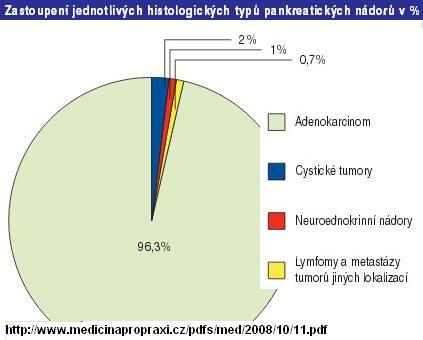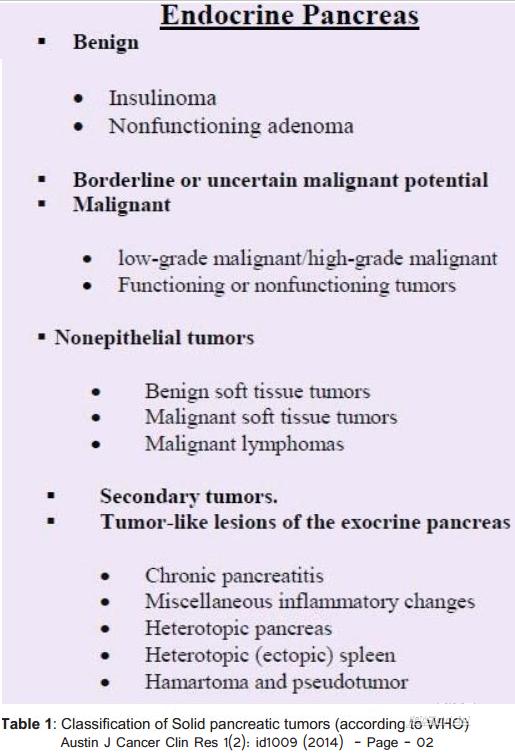nemoci-sympt/ONKOLOGIE/nadory-pankreatu/nadory-slinivky-maligni/typy-nadoru
Typy nádorů slinivky
- Majority are epithelial tumors
- 90% of these are ductal adenocarcinomas and their variants [7]
- Neoplasms originating outside the exocrine ductal epithelium are rare
- Pancreatic endocrine tumors
- Metastasis [7]


Variants of ductal adenocarcinoma
- Present a specific histological differentiation pattern
- Associated with a typical ductal adenocarcinoma component
A - Mucinous non cystic carcinoma
- Macroscopically gelatinous mass
- Better demarcated than the ductal adenocarcinoma [7]
- Incidence 1%–3% of all pancreatic cancers [7]
- Sex and age at onset are similar to those of ductal carcinoma [7]
- Significantly better than ordinary ductal adenocarcinoma [7]
B - Adenosquamous carcinoma
- Rare subtype
- 1%–4% of exocrine malignancies.
- Glandular and squamous cell component
- High metastatic potential
- Prognosis is worse than that of conventional adenocarcinoma
- Not present significant differences to a ductal adenocarcinoma
- Cannot be distinguished by imaging [7]
C - Undifferentiated (Anaplastic) carcinoma
- 5%–7% of all pancreatic tumors
- Prognosis is poorer than that of conventional adenocarcinoma
- Distant metastases frequently present at the time of the diagnosis
- Preferential in the tail of the pancreas [7]
D- Osteoclast-like giant cell carcinoma
- Subtype of ductal adenocarcinoma
- Malignant undifferentiated epithelial cells with round or spindle-shaped cells
- Associated with non-neoplastic osteoclast-like giant cells
- Extremely aggressive
- Most patients do not survive 1 year [7]
Další exokrinní typy nádorů slinivky
Solid Pseudopapillary Tumor of the pancreas (SPT) = solid cystic papillary epithelial tumor = papillary cystic tumor = solid and cystic tumor = papillary-cystic neoplasm = Hamoudi or Franz tumor
- Rare, low-grade malignant tumor
- Unknown etiology
- 0.2-2.7% of all primary pancreatic tumors
- Most prevalent in women of younger age
- Abdominal mass is the most common presenting symptom
- Dyspepsia, early satiety, nausea, or vomiting being less common
- Cca 20% of patients are asymptomatic
- CT shows a well-encapsulated heterogeneous mass in the pancreas
- With both solid and cystic components [7]
- Peripheral heterogeneous enhancement during the arterial phase
- Progressive non uniform enhancement thereafter
- The main differential consideration cystic NET/SPT tumors:
- Age at presentation
- NETs rarely occur in patients younger than 30 years of age
- Tumor enhancement characteristics.
- NETs are more vascular and demonstrate either diffuse or ring like hyperenhancement
- The pseudocapsule
- Composed of compressed pancreatic tissue and reactive fibrosis has low attenuation at CT
- Internal hemorrhagic and cystic degeneration
- Fragile vascular network of the tumor [7]
- 3 popsané kazuistiky spontánní regrese nádoru u dětí
- Degenerative change, hemorrhage and necrosis followed by absorption [7]
Pancreatoblastoma
- Rare pancreatic tumor
- Most common pancreatic tumor in early childhood
- Children in the first decade of life
- Occasional neonatal and adult cases have been reported [7]
- Aggressive with frequent local invasion, recurrence, and metastasis
- Complete surgical resection is the key to good prognosis in the absence of metastatic disease
- Chemotherapy and radiotherapy are recommended
- Recurrent, unresectable, or metastatic cases
- no standard regimen so far
- Adult pancreatoblastoma is an extremely rare neoplasm
- Less than 0.5% of all pancreatic exocrine tumors
- 24 cases that have been reported in the literature
- Slow growing
- Large tumors than 8 cm at the time of diagnosis
- Predominantly abdominal pain, weight loss, palpable mass and jaundice
- Metastasis is seen in 26% of adults
- Liver
- Lymph nodes
- Lung, bone, posterior mediastinum, peritoneum, and omentum [7]
- 1.3–2.7 times more common in males than in females
- Asian individuals >50% of cases
- ?-fetoprotein level is elevated in 25%–33% of cases
- Rarely causes biliary or duodenal obstruction
- Soft, gelatinous consistency [7]
- Arterial encasement
- Venous invasion
- Multiloculated inhomogeneous mass with enhancing septa
- Calcifications (when present) have a rim-like or clustered configuration [7]
Acinar cell carcinoma
- Cca 1% of all exocrine pancreatic tumors
- 10% of cases excess of pancreatic enzyme
- Lipase hypersecretion syndrome
- Subcutaneous fat necrosis
- Bone infarcts
- Polyarthritis [7]
- Prognosis is midway between ductal adenocarcinoma and endocrine tumors
- Only 6% have a 5-year survival
- Favorable prognostic factors are
- Less than 60 years of age
- Resectability
- Absence of metastases at intervention [7]
Pancreatic lymphoma
- Extra-nodal involvement of non-Hodgkin’s lymphoma
- In more than 50% of patients
- Most frequent site is:
- Stomach and small intestine
- Pancreatic lymphoma is uncommon
- Less than 0.5% of pancreatic tumors are of lymphomatous origin
- Only 0.2-2% of patients with non-Hodgkin’s lymphoma has pancreatic involvement
- Most of pancreatic lymphoma are diffuse large B-cell type
- LDH can be elevated in 50% of cases
- Tumor marker CA 19-9 may occasionally be elevated
- Most common presentation of pancreatic lymphoma is:
- Abdominal pain [83% of cases)
- Weight loss, nausea and vomiting
- Typical B-symptoms of lymphoma are uncommon:
- Fever
- Night sweats [7]
- Bulky localized tumor in the pancreatic head
- Without significant MPD dilatation
- Vascular invasion is less common in lymphoma than in adenocarcinoma
- Intratumoral calcification or necrosis is not a feature of lymphoma
- Beter prognosis than adenocarcinoma
- First-line treatment with chemotherapy is generally effective in producing long-term disease regression or remission
- Surgery is not required in most cases [7::
Metastases to the pancreas
- Cca 2% of pancreatic malignancies
- Lung cancer
- Breast cancer
- Renal cell carcinoma
- Malignant melanoma
- Carcinoma of gastrointestinal origin
- Prostate cancer
- Less commonly metastases from:
- Osteosarcoma
- Leiomyosarcoma
- Chondrosarcoma
- Surgical management seems to be associated with improved survival in these cases [7]
- In 5– 10% of patients
- Many small nodules
- Can coalesce occasionally into larger masses
Miscellaneous neoplastic solid exceedingly rare tumors
- Epithelial tumors
- Giant cell tumor
- Colloid carcinoma [7]
- Mesenchymal tumors
- Granular cell tumor
- Fibrous histiocytoma
- Juvenile hemangio-endothelioma
- Fibroma,
- Inflammatory myoblastic tumor
- Sarcoma [7]
- Mixed tumors
- Squamous cell carcinoma
- Usually carries a poor prognosis
- 25 cases median survival was
- 7 months for patients who underwent curative resection
- 3 months for patients who did not undergo curative resection [7]
- Mixed endocrine-exocrine tumor [7]

Pancreatic neuroendocrine tumors (NETs)
- Originate from pluripotential stem cells in ductal epithelium
- 1%–5% of all pancreatic tumors
- Equal gender distribution
- Typically manifest in patients aged 51–57 years
- Association with syndromes such as:
- Multiple endocrine neoplasia type 1
- Von Hippel–Lindau syndrome
- Neurofibromatosis type 1
- Tuberous sclerosis [7]
Functioning tumors - excessive hormone production
- 15%–52% of all tumors
- Subdivided according to the hormones they produce [7]
- Manifest early due to excessive hormone production [7]
Nonfunctioning tumors
- Manifest when they are large, due to mass effect
- Risk of malignancy increases with tumor size
- Especially in tumors >5 cm
- 90% of nonfunctioning tumors being malignant at presentation [7]
Single lesions
- In 90% of insulinomas
Multiple lesions
- Multiple endocrine neoplasia type 1
- Von Hippel–Lindau syndrome
- In 20%–40% of gastrinomas [7]
Conventional pancreatic endocrine tumors
- Generally hypervascular
- Frequently demonstrate avid, homogeneous enhancement in the arterial phase
- Imaging findings of a cystic NET are highly nonspecific
- Definitive diagnosis is generally difficult to establish
- Cystic degeneration
- The presence of residual peripheral enhancement when seen can be helpful establishing the diagnosis of a cystic PET [7]
Ampulomy
- Nádory Vaterské papily
- Nádory vycházející z koncové části žlučovodu
- Radikální operace ve stejném rozsahu jako u duktálních adenokarcinomů
- Prognóza je příznivější